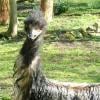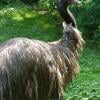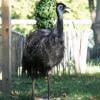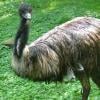The Emu is a prehistoric bird that originated about 80 million years ago in Australia. They are closely related to ostrich, rhea, cassowary and kiwi. These are flightless birds (they have very short wings and very weak wing muscles), but they can run very fast.
Found on the grassy plains of Australia, this is the third largest living bird. They have brown feathers with a white base, and each feather has a secondary feather that gives the bird a shaggy or furry look. The Emu is primarily a herbivore (plant eater). They eat seeds, grass, flowers, young plants and fruit. They do also eat some insects, particularly caterpillars.
Emus live in flocks, can grow up to 6’ (1.85m) tall and weigh up to 110 lbs (50kg). They can run very fast for short bursts, up to 40 miles (64 kilometres) an hour. Chicks have an incubation period of about 8 weeks. They have three toes; the underside of each toe is a broad flat pad. They can live up to 20 years in captivity.
ConservationStatus
Least Concerned
Near Threatened
Vulnerable
Endangered
Critically Endangered
Extinct In The Wild




